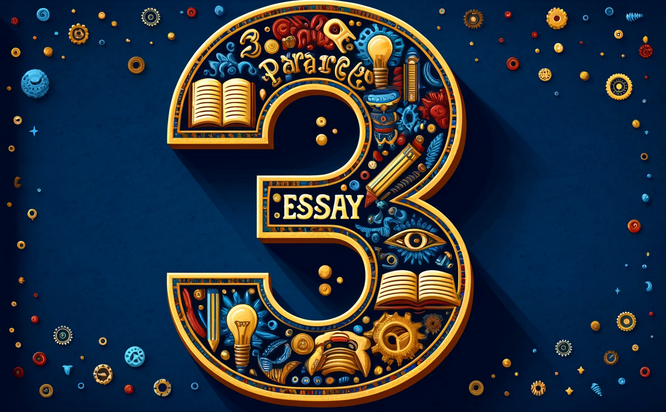Essay Writing Guides
Your Essential 3 Paragraph Essay Guide


This 1000 word essay explores the transformative impact of technology on education, highlighting both its benefits and challenges. It discusses how digital tools have enhanced learning experiences by accommodating diverse learning styles with multimedia content, and increased accessibility, allowing for remote learning and reducing educational costs. However, the essay also addresses significant challenges such as the digital divide, the potential degradation of basic academic skills due to over-reliance on technology, and concerns over data privacy and security. The conclusion calls for collaboration among educational stakeholders to mitigate these issues and maximize the positive impacts of technology in education.
Essay writing often appears to be a difficult task for students, arousing frustration and anxiety. Among the countless formats taught in academic settings, the 3 paragraph essay presents a unique challenge due to its brevity and stringent structural requirements. This article aims to clarify the process of writing a concise and impactful 3 paragraph essay. We will delve into students’ common obstacles, give a clearly defined structure, and provide practical tips to enhance writing skills. With these tools, students can transform their essay writing experience from a source of stress into a manageable, even enjoyable task.
The 3 paragraph essay, while less common than its 5 paragraph counterpart, is an excellent exercise in precision and clarity. Students and educators find this format valuable for developing critical thinking and argumentation skills within a confined space. This comprehensive guide will break down each component of the 3 paragraph essay, from the engaging introduction to the concise body and compelling conclusion. Additionally, we will provide 3 paragraph essay examples to illustrate how these elements combine to form a coherent and persuasive piece. Say goodbye to educational stress and welcome a straightforward pathway to writing success.
Understanding the 3 Paragraph Essay Structure
Before delving into how to craft a 3 paragraph essay, it’s essential to grasp its fundamental components. Like many academic essays, the 3 paragraph essay follows the traditional model consisting of an introduction, a body, and a conclusion. However, this format stands out by limiting each section to a single paragraph, streamlining the writing process. This structure benefits novice writers or those enhancing their English skills, providing a straightforward framework that simplifies the essay-writing journey.
The 3 paragraph essay encourages writers to concentrate their arguments into one powerful point per section rather than scattering their thoughts across multiple paragraphs. This approach not only sharpens the writer’s focus but also enhances the persuasive power of the essay by compelling the author to choose the most convincing argument to sway the reader’s opinion.
Once the initial planning phases, such as brainstorming or outlining, are complete, students can transition smoothly into writing the essay. The process follows the same foundational steps as other essay formats but distinguishes itself by its brevity. The body section’s concise nature significantly reduces the essay’s overall length, making it a less daunting task and allowing for a more compact, impactful final product.

Suggested Outline for a 3 Paragraph Essay
To better visualize the structure and flow of a 3 paragraph essay, here’s a detailed outline:
Introduction:
- Attention-Grabbing Hook: Start with a sentence that piques the reader’s interest.
- Brief Background Points: Provide essential context to set the stage for your thesis.
- Clear and Concise Thesis Statement: State your main argument succinctly.
Body:
- Topic Sentence: Introduce the main idea of this paragraph, which should support your thesis.
- First Supporting Fact: Present evidence or analysis that substantiates your point.
- Second Supporting Fact: Offer additional information to reinforce your argument.
- Smooth Transition Sentence: Lead smoothly into the conclusion, ensuring a coherent flow.
Conclusion:
- Restatement of the Thesis Statement: Recap your thesis in light of the arguments presented.
- Summary of Main Ideas: Briefly review the key points discussed in the body.
- Thought-Provoking Challenge to the Audience: Conclude with a statement encouraging further reflection or action.
This outline serves as a guide to simplify the writing process, ensuring your ideas are organized effectively and presented persuasively, creating a memorable impact on your audience. By adhering to this structure, you can master the art of the 3 paragraph essay, making your academic writing more explicit, direct, and ultimately more successful.
Paragraph 1: Introduction of the 3 Paragraph Essay
The introduction of a 3 paragraph essay sets the stage for what follows, providing the first impression that can either engage or dissuade your reader. It’s crucial that this opening paragraph captivates and informs, laying a solid foundation for the arguments to be developed in the subsequent sections.
Function of the Introduction The primary purpose of the introduction is to introduce the topic and assert its significance, convincing the reader of the essay’s worth. This section should present the topic at hand and motivate the reader to invest their time in understanding your viewpoint.
Elements of a Strong Introduction
- Hook: Begin with a hook that grabs attention. This could be a provocative question, a startling statistic, or a quote that frames the discussion compellingly. For example, starting with a question like, “Is there no solution for dumping waste in the ocean?” immediately draws the reader into a specific problem, setting the tone for a discussion on environmental issues.
- Background Information: After the hook, provide the necessary background information to help the reader understand the context of the topic in your 3 paragraph essay. This might include briefly explaining key concepts or summarizing relevant issues related to your thesis. For instance, explain why waste is dumped in the ocean and the scope of this practice, possibly supported by recent statistics or findings.
- Thesis Statement: Conclude the introduction of your 3 paragraph essay with a clear and concise thesis statement. This statement should encapsulate the central argument of your essay in one or two sentences. For the given example, a thesis could be, “Dumping waste in the ocean is a significant problem that spells disaster for the ecosystem, leading to extensive problems on land.”
Structuring Your Introduction A well-structured introduction serves as a roadmap for the writer and the reader, ensuring the core message is communicated effectively. Here’s how you might structure it:
- Hook: Pose a challenging question to spark curiosity.
- Background Points:
- Briefly discuss the prevalence of ocean dumping.
- Present data or statistics to illustrate the magnitude of the issue.
- Thesis Statement: Assert your main argument about the detrimental impacts of this practice on the environment and terrestrial life.
The introduction of your 3 paragraph essay is more than just a beginning—it’s a strategic component that can persuade your reader to see the importance of your topic and set the tone for a compelling argument.
Paragraph 2: Building the Body of a 3 Paragraph Essay
The body paragraph in a 3 paragraph essay is the core section where the main arguments and evidence in support of the thesis are presented. Unlike essays with multiple body paragraphs, the 3 paragraph essay consolidates all supporting details into a single, focused paragraph. This approach emphasizes clarity and depth over breadth, challenging writers to select the most compelling evidence and arguments carefully.
Function of the Body Paragraph The body paragraph’s role is to support the thesis statement introduced in the first paragraph fully. It should expand on the thesis by providing evidence and explanations that persuade the reader of the thesis’s validity. The effectiveness of this paragraph is critical, as it contains the substantive content of the essay.
Structuring the Body Paragraph To create a well-organized and impactful body paragraph, consider the following structure:
- Topic Sentence: Start with a strong topic sentence that clearly states the main point of the paragraph. This sentence should directly support the thesis and act as a guide for what will follow. For example, based on the thesis “Dumping waste in the ocean is a significant problem that spells disaster for the ecosystem, leading to extensive problems on land,” a good topic sentence might be: “The continued dumping of waste in the ocean severely disrupts marine life, which in turn affects food supply and biodiversity on a global scale.”
- First Supporting Fact: Introduce your first piece of evidence to back up the topic sentence. This could be a statistic, a quote from a credible source, or a case study. For instance: “According to a 2021 study by the Marine Environmental Research Institute, waste pollution has led to a 40% decline in marine biodiversity over the last five decades.”
- Second Supporting Fact: Provide additional evidence or an example to strengthen your argument further. This should build on the first fact, adding depth and breadth to your point. Example: “This decline in biodiversity not only threatens various marine species but also impacts fishing communities worldwide, leading to economic and food security challenges.”
- Smooth Transition Sentence: Conclude the body paragraph with a transition that seamlessly connects to the conclusion. This sentence should summarize the body’s content and lead the reader toward the final part of the essay. For example: “The degradation of marine ecosystems is therefore not just an environmental issue but a profound crisis that impacts food systems and economies globally, underscoring the urgent need for action.”
Building a Cohesive Body Paragraph Creating a cohesive body paragraph involves more than just listing facts. It requires integrating these facts into a narrative that supports the thesis statement comprehensively and persuasively. Each sentence should contribute to building a strong argument, with each fact logically leading to the next, ensuring the paragraph flows smoothly from start to finish.
By following this structured approach, you ensure that your body paragraph effectively supports your thesis and communicates your message clearly, preparing the reader for the conclusion where these ideas will be succinctly summarized and reaffirmed.
Paragraph 3: Concluding the 3 Paragraph Essay
The conclusion of a 3 paragraph essay wraps up the discussion by reinforcing the thesis and summarizing the key points made in the body paragraph. This final section is crucial as it leaves the reader with a lasting impression and a clear understanding of the essay’s significance.
The Function of the Conclusion The purpose of the conclusion of your 3 paragraph essay is to effectively close the essay, providing closure on the arguments presented while emphasizing the overall importance of the topic. It should restate the thesis in a new light, considering the evidence discussed, and challenge the reader to think deeply about the implications.
- Structuring the Conclusion A well-written conclusion should follow this structured approach to ensure it captures the essence of the 3 paragraph essay and resonates with the reader:
- Restatement of the Thesis: Begin by rephrasing the thesis statement to reflect the insights gained from the body paragraph. This restatement should echo the original thesis but with a deeper understanding, showing how the evidence supports the central argument. For example, “The ongoing pollution of our oceans through waste dumping not only devastates marine ecosystems but also threatens global food security and economic stability.”
- Summary of Main Points: Briefly summarize the major supporting points from the body paragraph of your 3 paragraph essay to remind the reader of the logical progression of your argument. Keep this summary concise and focused, highlighting how each point contributes to validating the thesis. Example: “As shown, the decline in marine biodiversity directly impacts fish populations and the livelihoods of fishing communities, illustrating the broader economic and social ramifications of ocean pollution.”
- Thought-Provoking Challenge to the Audience: Conclude your 3 paragraph essay with a compelling statement or question that encourages the reader to consider the broader implications of the issue or to take action. This part should inspire further reflection or motivate change, emphasizing the relevance of the topic beyond the scope of the essay. For example, “Given the critical role healthy oceans play in sustaining life on earth, it is imperative that we address this issue with urgency. What steps can we individually take to reduce our environmental footprint and safeguard our oceans for future generations?”
The conclusion of your 3 paragraph essay is not merely a repetition of what has been already said; rather, it’s an opportunity to reinforce the thesis and inspire the reader. By restating the thesis in light of the evidence provided and challenging the reader to think about the future, the conclusion serves as a powerful closing argument that enhances the impact of the essay.
By carefully following this structure, your conclusion will effectively encapsulate the essence of your argument and leave a lasting impression on the reader,
Editing Your 3 Paragraph Essay
Editing is a crucial step in the writing process, especially when crafting a 3 paragraph essay, where clarity and precision are paramount. This phase is not just about correcting spelling and grammar mistakes; it’s about refining your message and enhancing the flow of your essay to make a compelling argument.
Approaching the Revision Process
- Take a Break: After you finish your initial draft, step away from it for a while. This pause allows you to return to your essay with fresh eyes, making it easier to spot inconsistencies and areas that need improvement.
- Review for Cohesion and Flow: As you revisit your essay, focus on how the paragraphs connect. The transitions between paragraphs should be smooth, guiding the reader naturally from the introduction through the body to the conclusion. Evaluate whether the sentences at the beginning and end of each paragraph effectively introduce and conclude the ideas, and check if transition words like “furthermore,” “moreover,” or “therefore” are used to enhance the logical flow.
- Grammar and Punctuation Checks: Thoroughly check your essay for grammatical errors and punctuation mistakes. These can distract from the content and lead to misunderstandings. Tools like Grammarly, or your word processor’s built-in grammar check, can help automate this process, but personal review is irreplaceable.
- Polish Sentence Structure: Look at the structure of your sentences. Are they varied in length and style, or do they follow a monotonous pattern? Mixing complex and simple sentences can keep the reader engaged and emphasize key points more effectively.
Ensuring Accuracy and Credibility
- Verify Source Credibility: If your essay includes data, quotations, or any facts, double-check these elements for accuracy and credibility. Make sure your sources are reputable and up-to-date.
- Proper Citation: Accurately citing sources is crucial in academic writing to avoid plagiarism and to lend authority to your argument. Depending on the requirements of your assignment or the preferences of your educator, ensure that you format your citations according to MLA, APA, or Chicago style guidelines. This includes a properly formatted bibliography or works cited page.
- Seek Feedback: If possible, have someone else read your essay. Fresh perspectives can offer valuable insights and point out issues you might have overlooked. This could be a peer, a tutor, or a mentor.
- Final Read-through: Give your essay one last read, focusing on the overall narrative. Does your essay make a clear argument? Is the conclusion persuasive? This final pass can help you catch any lingering issues and ensure that your essay is coherent and compelling.
Editing your 3 paragraph essay is about fine-tuning your arguments and ensuring your writing is clear and persuasive. By taking the time to revise thoroughly, you can significantly improve the quality of your essay, making it not only a reflection of your ideas but also a showcase of your writing skills.
3 Paragraph Essay Example 1 on Ocean Pollution
This 3 paragraph essay explores the weighty issue of ocean pollution, specifically focusing on the consequences of waste dumping in marine environments. It highlights how millions of tons of waste annually endanger marine biodiversity and ecosystems, leading to severe repercussions not only for marine life but also for human communities dependent on these ecosystems. The essay discusses a study revealing a significant 40% decline in marine biodiversity over five decades due to pollution. This ecological crisis threatens global food security and economic stability, underscoring the urgent need for concerted action. The essay calls for individual and collective efforts to reduce our environmental footprint and protect our oceans, which are crucial for sustaining life on Earth.
3 Paragraph Essay Example 2 on Impact of AI in Healthcare
This essay explores the economic impact of Artificial Intelligence (AI) in healthcare, emphasizing its potential to reduce costs and enhance service delivery. It discusses how AI improves diagnostic accuracy, optimizes treatment protocols, and enhances operational efficiencies, thereby significantly lowering healthcare costs. By focusing on AI’s role in early diagnosis and personalized medicine, the essay highlights the substantial economic benefits, including a reduction in unnecessary procedures and more effective resource allocation. Ultimately, the essay argues that AI not only supports economic sustainability in healthcare but also improves patient outcomes, advocating for increased investment and integration of AI technologies in healthcare systems.

Essay Workload Is Getting Tougher?
Opt for academic relief with our professional service.
Final Remarks
Mastering the art of writing a 3 paragraph essay is an essential skill for both academic and professional success. This concise form of essay writing demands precision, clarity, and a well-defined structure, consisting of an introduction, a body, and a conclusion. Each section serves a specific purpose, making every word count in a tightly constructed argument. Regular practice in writing these essays can significantly enhance your ability to formulate and present clear, compelling arguments concisely.
For those looking to elevate their writing skills further, exploring services like the Masters Writers’ Essay Writing Service can be incredibly beneficial. Engaging with experienced instructors can provide deeper insights into effective writing techniques and strategic structuring. These services help ensure your essays are not only well-organized and persuasive but also impactful, leaving a lasting impression on your readers. Whether you are addressing complex subjects or seeking to refine your writing style, the guidance from writing experts can provide a substantial boost in your writing endeavors, empowering you to succeed across various communication settings.
FAQs
How to write a 3 paragraph essay?
To write a 3 paragraph essay, start with a clear and concise introduction that includes a hook to grab the reader’s attention, background information on the topic, and a thesis statement. Follow with a body paragraph that presents the main arguments supporting the thesis, using evidence and examples. Conclude with a paragraph that restates the thesis in light of the evidence presented, summarizes the main points, and possibly offers a final thought or call to action.
How long is 3 paragraphs?
The length of three paragraphs can vary depending on the context and purpose. However, in a typical 3 paragraph essay, each paragraph might range from 100 to 200 words, making the total length approximately 300 to 600 words.
How to start a 3rd paragraph?
Yes, a 3 paragraph essay includes exactly three paragraphs, structured as an introduction, a body, and a conclusion. This format is a simplified version of more traditional essays, designed to teach basic essay structure without overwhelming the writer or reader.
Are there 3 paragraphs in an essay?
The third paragraph in a 3 paragraph essay is the conclusion. Start this paragraph by restating the thesis statement in a new way, reflecting the discussions from the body paragraph. Follow with a concise summary of the main points or evidence that supports the thesis, and conclude with a final remark or a call to action that leaves the reader with something to ponder or act upon.

